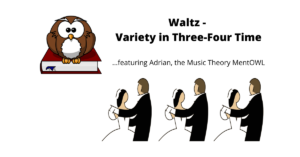Family celebrations are an exciting thing. If there are young children in your family, you know that singing the theme tunes of current children’s series is always highly appreciated. Wouldn’t it be practical if you knew the principles of simple song accompaniment and could spontaneously sit down at the piano to accompany a song? Together with Adrian, the Music Theory MentOWL, I’ll show you how to do it.
What you will read in this article:
Song accompaniment is a skill in demand
You are at a family celebration. Suddenly someone starts to warble a song – maybe he or she picked up a melody on the car radio or is just remembering the last rehearsal of the church choir. Or maybe you have young children in the family. Then you know that the title melodies of current children’s series are always very popular. Since these series often run in a continuous loop, the corresponding title melodies are usually known to the general public – everyone knows them.
And so it doesn’t take long until half the family sings along – those who don’t dare to sing, hum or whistle. Until your great-aunt Erika, who always had the strangest ideas, suddenly looks at you with big eyes and asks: “Can you accompany us?
If you then get a bright red head and start stammering, don’t panic: There is still Adrian. Admittedly, he is sometimes a bit moody (you didn’t hear that from me!), but always helpful. That’s why he explains to you first of all what “accompaniment” actually means:

Adrian, the Music Theory MentOWL:
Thanks, Adrian!
Well, you can safely ignore the last part of Adrian’s explanation for the average family celebration. A whole opera aria will probably not be performed there, not even by great-aunt Erika. A folk or children’s song, on the other hand, is more likely. For example one like this one:

Now, how can you accompany this? Let’s have a look at what pitches appear in this short piece of music:

It is a complete scale without accidentals on the base note c, which means that you are dealing with the key of C major. So far, so good. But what happens next?
Song accompaniment with triads

Adrian, the Music Theory MentOWL:
“Above each of these steps a triad can now be constructed by layering two thirds above it. The pitches required for this are also taken from the material of the scale. 1
Aha! We form so-called triads! What Adrian means, looks like this in the result:

And now I’ll tell you one of the most amazing secrets of the art of song accompaniment: you don’t need all of these triads. Most of the time you do not even need half of them. And very, very often only three are enough for you, namely those of the first, fourth and fifth level.
Why? Because these triads contain all the notes of the corresponding scale:

Because the triads of levels I, IV and V are so important and universally applicable, they are also called the basic harmonies.
The right triad at the right time
So now you know that you can accompany a simple song using the three basic harmonies. The only question is where in the song you can underlay which basic harmony. After all, you can’t just go wild, even if you only use the three basic harmonies:


Adrian, the Music Theory MentOWL:
“ARGH!!! STOP IT!!! STOP IT RIGHT NOW!!!”
Excuse me, Adrian. I wanted to make this point very clear.
If you have read my article about syncopation, you already know that in a 4/4 bar heavy and light counts alternate. You can now use this knowledge for simple song accompaniment by looking at which notes are on each count:

Did you notice? You can now easily play one of the three basic harmonies on any heavy count. You choose the one that best summarizes the melody notes:


Adrian, the Music Theory MentOWL:
“Much better.”
And here it is, the simple song accompaniment! Great-aunt Erika is happy, the rest of the family is singing like in a frenzy, and you are the star of the family celebration.
By the way: great composers like Mozart did not only use the basic harmonies, but also understood the artful application of the secondary harmonies, which they often achieved through puzzling harmonic turns. I discuss such an example in my article about the first movement of Mozart’s “Prague” Symphony.

Jonathan Stark – Conductor
Hello! I'm Jonathan Stark. As a conductor, it is important to me that visits to concerts and operas leave a lasting impression on the audience. Background knowledge helps to achieve this. That's why I blog here about key works of classical music, about composers, about opera and much more that happens in the exciting world of music.








Lieber Adrian-GurUHU,
mir gefällt es sehr, was du da in deiner hoffentlich nicht mehr allzu lang andauernden Zwangsfreizeit in Seelbach zusammengestellt hast.
Alles Gute und Gruß aus Binzen
Thomas Eßer
Lieber Thomas, vielen Dank für das Kompliment! Liebe Grüße, Jonathan und (KRAH!) Adrian